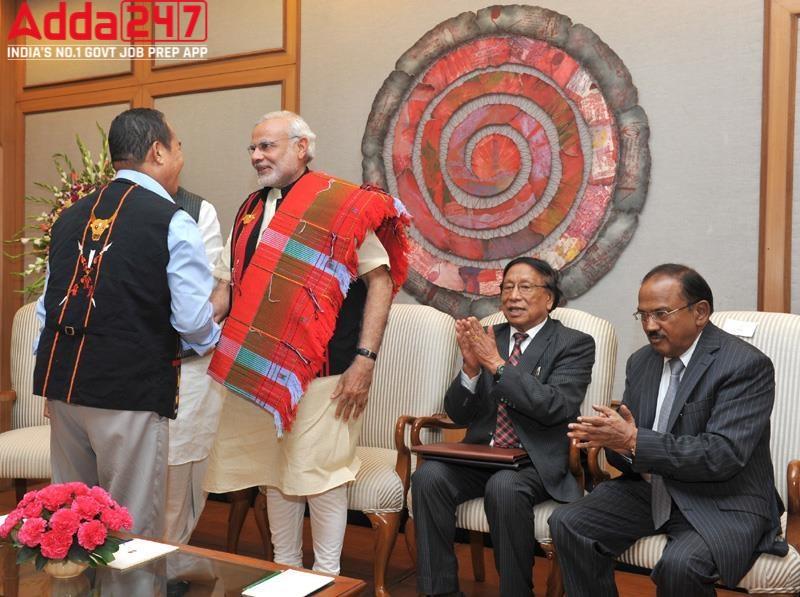Recently, on August 1, 2022, the NSCN (I-M) observed the 25th anniversary of the “Indo-Naga” ceasefire with the release of a booklet titled “25 Years of Indo-Naga Ceasefire (1997-2022)”.The NSCN-IM signed a ceasefire agreement with the Government of India on July 25, 1997, which became effective on August 1, 1997. This heralded the start of Indo-Naga peace talks. It opened an avenue in the search for a solution to the long-standing political demands of Nagas living across the region between India and Myanmar.
Bank Maha Pack includes Live Batches, Test Series, Video Lectures & eBooks
About The History Of Nagas:
- The late Kaka D Iralu, in his book The Naga Saga (2000), articulates that Naga nationalism is an outcome of the aspirations of the Nagas to reclaim an independent Naga nation which existed before the British set foot in the lands of the Nagas. He argued that since then, self-determination and political meanings had been integrated into the idea of nationalism for the Nagas. The words from Iralu speak in volume to the length and breadth of the Nagas’ demands for a solution to the ongoing Indo-Naga peace talks.
- At this moment, the past reminds the Nagas of how their ancestors were denied their rights and territories. Dating back to the early nineteenth century, the British’s takeover of Assam and Manipur in 1826 with the Treaty of Yandabo led to the gradual conquest of the Nagas from 1832. The year 1881 marked the conquest of the Naga Hills by subduing the Nagas. Around the time of the Naga Club’s memorandum to the Simon Commission, asserting their self-determination in 1929, the Zeliangrong movement upheld the fight against the British to bring about freedom for the Nagas.
- The emergence of the Naga National Council (NNC) in 1946 kept alive the need forthe sovereignty of Nagas. In response to the NNC, then prime minister Jawaharlal Nehru’s militarised intervention against the Nagas paved the way for the Armed Forces Special Powers Act (AFSPA), which is still in force. A few decades later, the Shillong Accord in 1975 led to the formation of the NSCN, which split in 1988 and formed the NSCN-IM, led by Isak Swu and Thuingaleng Muivah, and NSCN-K, led by Khaplang. In 1997, the NSCN-IM and the Government of India entered a ceasefire agreement.
About The Peace Talk:
- Sometime in 2001, the NSCN-K also joined the Indo-Naga peace talks with the Government of India, but left it in the year 2015 and rejoined in 2019. From 1997 onwards, several rounds of talks were held, which finally culminated in the Framework Agreement signed between the Government of India and the NSCN-IM in August 2015. The agreement identified the unique history of the Nagas and acknowledged the decades of struggles for their political demands. Yet, the agreement is far from reaching a solution for the Nagas. Since 1997, the NSCN-IM has remained the primary stakeholder in the Indo-Naga peace talks.
- However, the peace talks have also seen the participation of various groups, particularly the Naga National Political Groups (NNPGs), since 2017. In the recent past, the Centre, represented by interlocutor R N Ravi, conducted several rounds of meetings in which he included several Naga political groups. This was signalled as a step towards inclusivity, which boiled down to the speculated October 31, 2019, for concluding the peace talks. To the echoes of inclusivity, it is important to note the Naga Mothers’ Association (NMA) statement made around that time where it appealed for proper inclusivity, urging for inclusion of the Naga Hoho (NH), the NMA, the Naga Students’ Federation (NSF) and the Naga Peoples’ Movement for Human Rights (NPMHR) on the basis of their contribution to the peace process for decades. The Eastern Nagaland Peoples’ Organisation’s (ENPO) demand for ‘Frontier Nagaland’ since 2010 also raised a question about the existing idea of inclusivity among the Nagas.
The Recent Development:
In the year 2020, the interlocutor, Ravi, made it to the news when his letter addressed to the Chief Minister of Nagaland was leaked on June 25. The incident led to distrust as Ravi had painted the Nagaland government and the insurgents in a bad light, linking them to failures of law and order. Following this incident, the NSCN-IM released the contents of the document of the Framework Agreement of 2015 in August 2020. Eventually, in September 2021, Ravi quit and was replaced by former IB special director A K Mishra as the sixth interlocutor for the Indo-Naga peace talks. The soured relationship between the NSCN-IM and Ravi was put to an end. The peace talks have now resumed to achieve a solution for the Nagas soon.
The Approach After 25 Years:
As the Indo-Naga peace talks marked their 25th year this August 2022, the prospect of the solution to Naga political demands still has no clear answers. The NSCN-IM remains firm over its demands for a separate flag and constitution for the Nagas. The hope for the unification of all the Naga-inhabited areas continues to live in the minds and aspirations of the Nagas. Recently, the Global Naga Forum (GNF) organised a two-day “Naga Solidarity Walk” from Kohima, Nagaland, to Senapati, Manipur, under the theme “One People, One Destiny”. The rally demonstrated that the Nagas are one and uphold Naga history and the need to defend their lands.



 Indian Olympic Medal Winners List Till N...
Indian Olympic Medal Winners List Till N...
 Who is the Inventor of the Gramophone?
Who is the Inventor of the Gramophone?
 HS Dhaliwal Appointed New DGP Of Andaman...
HS Dhaliwal Appointed New DGP Of Andaman...
